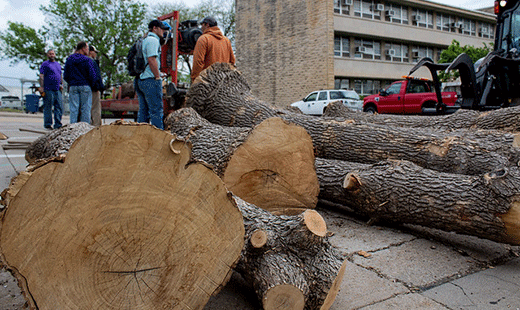
Kansas State University has teamed with the Kansas Forest Service to proactively manage ash trees on campus. Many of the trees being removed because of the emerald ash borer are being milled and will be used in projects across campus. | Download this photo.
K-State campus ash trees find new life in wood utilization projects
Demonstration raises awareness of borer and how to manage it proactively
May 13, 2019
MANHATTAN, Kan. – Ash trees across the Kansas State University campus are being removed as a proactive measure to minimize the effects of the emerald ash borer; an exotic, invasive insect that is decimating the ash tree population as it moves westward across the country.
“Emerald ash borer is a threat to the area,” said Dave Bruton, marketing and utilization forester with the Kansas Forest Service. “It is not yet to the Manhattan area, but K-State is being proactive in removing ash trees, so they do not have to remove all the trees at one time.”
The key to an effective EAB plan like K-State’s is proactive management that works in advance of an infestation and therefore, spreads out the economic and environmental impact. In keeping with a K-State EAB Readiness Plan, a majority of the 251 ash trees on campus will be removed in anticipation of an inevitable infestation in the area.
Trees flagged for removal include those in decline, with poor structure or serious defects, or those in poor locations. When all of the identified ash trees around campus are removed, replacement trees will be planted.
“Instead of just chopping them for firewood or taking them to the landfill we decided as a committee to look at ways we could use the trees,” said Ryan Swanson, associate vice president of facilities and university architect at K-State.
Committee members from the K-State Campus Planning, Facilities Management, Landscape Advisory Committee and the Kansas Forest Service have moved ahead with a plan to mill lumber from the ash trees to be used in design or capital building projects. Last week, ash trees removed around Dole Hall were milled into boards at a milling demonstration sponsored by the Kansas Forest Service and the K-State Division of Facilities.
“Each tree is unique. Just like people, you never see one exactly alike,” said Bruton. “When we mill through these, we are finding unique pieces in here.”
Milled boards from the demonstration will be utilized in campus building and design projects. Capital building projects on campus are two to three years out in the planning stages, but Swanson said, “If we don’t have it, we can’t use it.”
For now, he and his team in the Division of Facilities will season the milled lumber for experimental projects. Unique milled lumber, like that from campus ash trees, can be used to build tables, wainscoting, architectural ceilings and other applications.
“Architecturally, ash is a bit brighter than say a walnut or a darker wood. It does have a nice chocolate tone where you have knots,” said Swanson. “I think all wood has character, but knowing this wood came from here on campus gives it more character.”
Though EAB has required the proactive removal of trees across campus, many trees will continue contributing to the beauty of campus.
Learn more about EAB and K-State’s plan for the infestation on the Division of Facilities website: https://www.k-state.edu/facilities/operations/landscape/index.html

